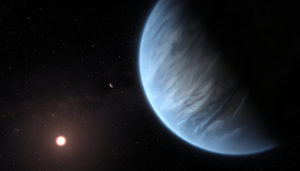- Series:Astronomy, Creation, Transcript English
Psalm 19:1
“The heavens declare the glory of God; and the firmament sheweth his handywork.”
 Astronomers say that they have found an Earth-like planet 124 light years away. It is 2½ times the radius of Earth, and 8½ times the mass. The planet – called K2-18b – is reported to have an atmosphere of hydrogen, water vapor, methane and ammonia. Notice that this mixture of gases is precisely what evolutionary astrophysicists claim was in the Earth’s atmosphere prior to the evolution of life.
Astronomers say that they have found an Earth-like planet 124 light years away. It is 2½ times the radius of Earth, and 8½ times the mass. The planet – called K2-18b – is reported to have an atmosphere of hydrogen, water vapor, methane and ammonia. Notice that this mixture of gases is precisely what evolutionary astrophysicists claim was in the Earth’s atmosphere prior to the evolution of life.
Such details might lead the listener to ask, “How do they know all this?” It is a fair question because we have already discussed in these Creation Moments that they cannot actually see planets like this, even with the Hubble Space Telescope. Instead, perturbations in the orbit and spectrum of the host star are measured and the existence of the planet is – reasonably enough – inferred. However, the specific details about amounts of gases comes not from observations, but from computer models. Computer modelers must input some data to begin with and, in this case, have inferred an atmosphere similar to their old earth conjecture.
Research is a worthwhile pursuit, justified by passages such as Psalm 19. Even computer models might have their place. However, a good programming principle is GIGO – Garbage In, Garbage Out. If astrophysicists start with evolutionary assumptions, it is not surprising that their models give evolutionary conclusions. God told us what the foundations of our science should be in Genesis 1, and if we start there, our research will bear fruit.
Prayer: Truly, Lord, the heavens declare the glory of God. Amen.
Author: Paul F. Taylor
Ref: University of Cambridge. “Large exoplanet could have the right conditions for life.” ScienceDaily, 26 February 2020. <www.sciencedaily.com/releases/2020/02/200226212008.htm>. Image: Artist’s impression, ESA, CC BY-SA 4.0 International.
© 2021 Creation Moments. All rights reserved.
Click here for our featured DVD: Astronomy Reveals Creation.
